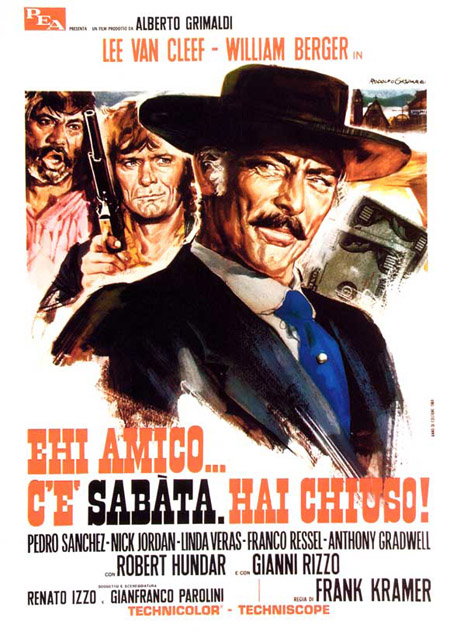BY FRED BLOSSER
On a windy night, a black-clad stranger rides
into Daugherty City, Texas. He flips a coin to a scruffy drunk who is
strapped for the price of a drink. He exposes a crooked dice game in the local
saloon, where most of the townsfolk seem to be congregated.Then he departs. In the meantime, down
the street, a gang of acrobatic robbers breaks into the bank and heists a safe
containing $100,000 in Army payroll money. The getaway crew escapes town before a wounded
trooper can raise the alarm, but out on the trail they run into the stranger,
Sabata, who picks them off with a tricked-out rifle and recovers the stolen
money.
Thus, in under 15 minutes of running time,
Gianfranco Parolini neatly sets up the events that will drive the remaining 90
minutes of his 1969 Spaghetti Western, "Ehi
amico... c'è Sabata, hai chiuso!" -- better known simply as “Sabata,”
as United Artists retitled the English-dubbed version that debuted in the U.S.
in 1970. The original Italian title translates to something like, “Hey,
Pal, Sabata’s Here, You Lose” . . . or maybe closer to the film’s rambunctious
spirit, “. . . You’re Screwed.”
Bracketing the opening credits, Parolini
economically introduces most of the movie’s main characters, establishes their
personalities, and through their interactions with Sabata and each other,
defines the interpersonal relationships that will drive the plot.
Sabata (Lee Van Cleef), the sharp-eyed “man who
knows,” as the drunk Carrincha (Pedro Sanchez) calls him, deduces that the men
behind the attempted robbery are the local businessman Stengel, his partner
Ferguson, and their crony Judge O’Hara (Gianni Rizzo). He approaches them and
demands $10,000 in hush money. Refusing, Stengel dispatches one assassin after
another to kill him. Stengel’s
henchman Slim, a hulking gunman named Sharky, two hit men dressed like the Earp
brothers, and a nervous killer disguised as a clergyman all try and fail. With each attempt, Sabata
raises his price higher and higher.
An old acquaintance, barroom minstrel Banjo
(William Berger), one of the supporting characters deftly sketched in the
opening saloon scene, ambles in and out from the periphery, toting his own
tricked-out weapon, a carbine hidden under his musical instrument. Sometimes he sides
with Sabata for money, sometimes he works for Stengel; in any event, not to be
trusted by either. He
and a greedy saloon girl, Jane, have a sort of romance characterized by mutual
boredom and availability. Carrincha
and a mute Indian acrobat, Alley Cat (Nick Jordan), help Sabata.
Arguably, “Sabata” represented the high tide of
Spaghetti Western popularity in the States in 1970, benefiting from the
box-office success of Sergio Leone’s groundbreaking films and preceding the
decline of the genre as it sputtered toward a slow box-office death in the
mid-‘70s. Where
Leone’s movies were generally panned by mainstream U.S. media on their initial
release, but nevertheless attracted a small early following of more progressive
critics, “Sabata” ironically met the opposite reception.
for the rest go
here: http://www.cinemaretro.com/index.php?/archives/8086-CINEMA-RETRO-SPECIAL-REPORT-VIVA-SABATA!-REFLECTIONS-ON-THE-LEE-VAN-CLEEFYUL-BRYNNER-TRILOGY.html


No comments:
Post a Comment